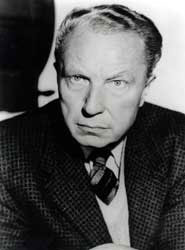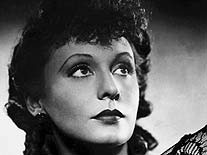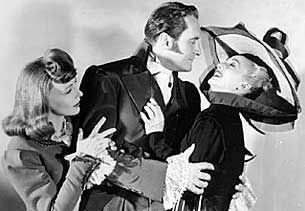 Auteurist critics have embraced the whole of Douglas Sirk’s work for at least 35 years, an intellectual clinch first marked by the filmmaker’s entry in Andrew Sarris’s "The American Cinema 1928-1968." Summer Storm, A Scandal in Paris, There’s Always Tomorrow, All That Heaven Allows, Written on the Wind, Imitation of Life – these have been long acknowledged as unadulterated masterpieces. But celebrating Sirk was a more hazardous venture than, say, fêting Samuel Fuller, mainly thanks to the fact that so many of the films that the Danish-born, German-bred director made at Universal during the 1950s are melodramas.
Auteurist critics have embraced the whole of Douglas Sirk’s work for at least 35 years, an intellectual clinch first marked by the filmmaker’s entry in Andrew Sarris’s "The American Cinema 1928-1968." Summer Storm, A Scandal in Paris, There’s Always Tomorrow, All That Heaven Allows, Written on the Wind, Imitation of Life – these have been long acknowledged as unadulterated masterpieces. But celebrating Sirk was a more hazardous venture than, say, fêting Samuel Fuller, mainly thanks to the fact that so many of the films that the Danish-born, German-bred director made at Universal during the 1950s are melodramas.It’s not that melodrama qua melodrama is held in widespread disdain, at least so long as you don’t use the dreaded "m" word to start. Vittorio De Sica’s The Bicycle Thief is pure melodrama, but because it’s called is in Italian, shot in the streets, superficially realistic and, above all, "masculine," no one gives it another thought. But Sirk’s Universal melodrama’s were American, shot in the studio, highly stylized and "feminine." All the words used to describe Sirk’s melodramas are stigmatizing words.
Additionally, Sirk’s films often featured Rock Hudson, one of Universal’s few box office draws, as a leading man, and Hudson has always been a target. For years, he was made fun of for what was considered his wooden acting. Now, he’s a loaded figure for his once covert, now exposed, homosexuality; a school of critics "reads" his gayness into his performances to the point where it supposedly supercedes the films.
Another group of critics, interested in feminist issues, interests itself in the "reception" of Sirk’s films, in their political context, etc, etc.
In the process, poor Sirk and his movies get lost all over again. The shame of this is that he was a major talent who made great films, one of cinema’s great visual stylists, a bracingly sardonic ironist, a leftist who got away working in the Hollywood system (not to mention under the Nazis), and that rare thing, an artist who was also an intellectual. He had a substantial and superb body of work before he landed at Universal and his style and thematic preoccupations were well set from an early point in his career.
Sirk was either born in Denmark or in Germany to Danish parents in 1900 and christened Claus Detlev Sirk. In his teens, he moved to Germany, the land of Goethe, to study the arts and humanities, changing his name to Detlef Hans Sierck. Following his studies, he landed a career in the theater, soon becoming a leading director, adaptor, and translator. He also developed the leftist politics that would become an integral part of his artistic identity and dictate much of the course of his life. In 1934, figuring that the newly empowered Nazis wouldn’t interfere in the movie business as much as they were in the theatrical world, he entered the cinema.
During this German period he married twice, first to a woman who later became a Nazi. His second wife was Jewish a fact which may have helped him escape from Germany in 1937. Sirk, whose movies were box office hits, went to Italy to "scout locations" for a new film, actually a ruse to plan an escape. The Nazis let his wife accompany him, probably in the hopes she would leave Germany and Sirk. But Sirk feigned an illness and entered a hospital run by sympathetic nuns who helped him and his wife slip out of the country. Eventually, the couple made it to the U.S., where Sirk again changed his name, this time to the one we know him by today.
 On the evidence, Sirk does not seem to have served an artistic apprenticeship. From the first, his film’s are more than mature; you could almost call them virtuosic, the work of a fully-formed artistic personality though perhaps influenced by Lubitsch. 1937’s Zu Neuen Ufern (literally To New Shores, but also known as Life Begins Anew and Paramatta) is an excellent example. Set in London and Australia during the middle of the 19th century, it’s centered on the travails of two people, the feckless soldier and adventurer, Albert Finsbury (Willy Birgel) and his sometime lover, the musical hall star Gloria Vane (Zarah Leander, a Swede who would become a huge star throughout Nazi-occupied Europe).
On the evidence, Sirk does not seem to have served an artistic apprenticeship. From the first, his film’s are more than mature; you could almost call them virtuosic, the work of a fully-formed artistic personality though perhaps influenced by Lubitsch. 1937’s Zu Neuen Ufern (literally To New Shores, but also known as Life Begins Anew and Paramatta) is an excellent example. Set in London and Australia during the middle of the 19th century, it’s centered on the travails of two people, the feckless soldier and adventurer, Albert Finsbury (Willy Birgel) and his sometime lover, the musical hall star Gloria Vane (Zarah Leander, a Swede who would become a huge star throughout Nazi-occupied Europe).
Finsbury is capable of a certain amount of gallantry when it can be cheaply displayed: When Gloria is booed by some blue-noses during a performance, he leaps on stage to defend her with witty japes. But on the night before he sails for Australia to join his detachment of the Guards, he falsifies a check from a friend, turning 15 shillings into 615. To save his honor, Gloria is forced to take the blame, and she’s convicted in court and sentenced to be transported to Australia and imprisoned there in the Paramatta workhouse and prison. After some months, a local Australian farmer, Henry Hoyer (Viktor Staal) proposes marriage to her, one of the few ways for a female convict to gain release. Gloria agrees to the match but she absconds to find Finsbury and only ends up in more trouble. Finsbury, though, is heading for further disgrace, thus putting the two of them on colliding, downward parabolas.
Finsbury and Gloria represent two of the basic character types that Sirk would play with throughout his own career. Finsbury is, to use Sirk’s word, a "divided" personality. He’s libidinous, susceptible, inconstant, impulsive. Gloria is solid. She’s given less to eros than to amour, she’s steadfast, controlling, calculating. As always in Sirk’s films, these two types are attracted to each other, though as time went on, the director tended to throw a third party into the mix, or even a whole other couple.
As a "divided" character, Finsbury is often in the process of disintegration and so in the need of wearing a mask that will camouflage his lack of self. Any social occasion turns into a theatrical event, his presence into a performance, a uniform or even normal suit of clothes into a costume. But Finsbury and his ilk must live in fear on the one person who will reach up and pull the mask from his face and reveal the true face – or lack of face – behind it.
Sirk stages a brilliant scene in the film where Finsbury is attending a fancy party thrown by the royal governor in honor of Finsbury’s engagement to his daughter. Outside the party, Gloria lurks, saddened beyond words by loneliness, loss and the pain of betrayal. Inside, though, Finsbury is hardly enjoying himself. He’s wracked by fear and guilt, since he’s known for some time that Gloria has been sentenced to Paramatta, having received a smuggled letter from her. Sirk’s camera darts from inside the governors mansion and out, the line of demarcation a set of windows and doors that alter our perspective, the relationship between the watching Gloria and the watched Finsbury, and the emotional temperature of the scene. It’s brilliant.
The irony – and few filmmakers were as fond of irony as Sirk – is that while Gloria is the literal performer, Finsbury is the actual one, and Gloria’s presence in Australia threatens to upend Finsbury’s delicate position. The officer is about to marry the royal governor’s daughter while carrying on an affair with a doctor’s wife, a difficult enough juggling act without the arrival of an old lover who took the fall on a forgery rap.
Gloria hides out from Henry by taking a job as a singer in a low dive, which is where Finsbury finally meets up with her again. There, backstage where the performers peel off their costumes and makeup, the two can finally confront each other on something approaching a friendly, or at least honest, basis. It’s far from the end of the story, but it’s a telling respite, and perhaps all Sirk ever really gives his characters. If you watch Sirk’s films as closely as you listen to them, you’ll notice that they don’t really conclude so much as pause, deliberately unfinished.
 The hallmark of Sirk’s visual style involves mirrors, shiny surfaces windows, window frames, doorways, architectural elements – anything that will give us two looks at the human face, put the human figure in shadow or silhouette, or carve up the frame in order to isolate people from one another. It’s an extraordinarily dynamic approach and positively explosive in his American film, A Scandal in Paris, made in 1946.
The hallmark of Sirk’s visual style involves mirrors, shiny surfaces windows, window frames, doorways, architectural elements – anything that will give us two looks at the human face, put the human figure in shadow or silhouette, or carve up the frame in order to isolate people from one another. It’s an extraordinarily dynamic approach and positively explosive in his American film, A Scandal in Paris, made in 1946.
Zu Neuen Ufern Sirk had conjured up echoes of Threepenny Opera (which Sirk had directed in Bremen) with its use of music; throughout the film choruses in different musical styles added add flavor the proceedings, including a courtroom scene in which a street singer Weill-like strains added stringent political commentary. In Scandal, we’re treated to large flavors of Moliere and even some more Lubitsch. We’re getting Sirk at his most lighthearted, until the end. Then, the movie suddenly turns dark and, as if we didn’t know it all the time, we’re reminded that we’re watching a film that could have been made by only the redoubtable ironist.
Set around 1800-10, the film stars the exquisitely perfect George Sanders as Eugene Vidocq, a highly improbable, but actually quite real historical figure who spent the first half of his life as a master thief and the second as France’s chief policeman. Naturally, the film, which is narrated by the Vidocq character, is much more interested in the criminal half of his career.
It practically goes without saying that Vidocq is the divided character, but he’s hardly tortured in the manner of Finsbury. On the contrary, he’s quite happy masquerading as this gentleman or that, robbing people as he goes along. The apex of his performances comes when he and his thick-featured aide-de-crime, Emile (Akim Tamiroff), pose as St. George and the Dragon for an artist restoring a church mosaic. No sooner has the artist finished his job, than Vidocq and Emile ride off on the "saint’s" white charger, adding horse thievery to their résumés.
Appropriately for farce, Scandal’s plot is quite complicated. But by the time the climax rushes into view, it has collected several key characters, including a sweet, innocent young woman, Therese (Signe Hasso); another of Sirk’s music hall singers, Loretta (Carole Landis); the singer’s husband, a defrocked police chief (Gene Lockhart); as well as Emile’s entire family of criminals. Vidocq has become the Paris police chief and is planning to knock off the Bank of Paris with the help of Emile’s family, whom he’s placed in jobs throughout the bank.
Suddenly, though, the tone shifts. Characters start to die. Loretta has always been a strangely shadowy figure, figuratively and literally. Three times we see her behind a shade: First, when she’s performing her act, singing from behind a thin paper hoop backlit by candle light. And last, when her husband shoots and kills her in a "blind" rage when she’s behind a backlit dressing curtain. The husband is blinded by rage, yes, but Loretta, one of those divided characters herself, has cuckolded him with Vidocq and probably others, by offering him false images of herself. In the end, these false images, mere silhouettes, misled both of them. Here, the steadfast, solid character, the husband, is a fool, but so is the divided character, Loretta. Yet, as the action plays out, we can only pity both of them.
What of the divided Vidocq" As you might have guessed, he has the innocent Therese to lead him to a path of righteousness with her simple honesty, her uncomplicated faith. He goes walking through a park with her and her little sister, who runs off to play on a tiny carousel. Alone together, Vidocq and Therese talk about her faith, his faith, regained innocence and love, and just then the little sister invites the grown-ups to join her. They agree to get on the little merry-go-round and immediately it’s clear that Sirk is invoking Jesus’s call to become like little children. So sweet.
But Sirk never wraps things up, remember. There’s another solid character, only solidly evil. And the carousel not only becomes a site of ugly violence, but it’s arms form a dark shadow over Vidocq that makes it very clear that no matter what happy scenes may follow, he will never rid himself of his darker side.
END OF PART ONE
